Packing Up a War
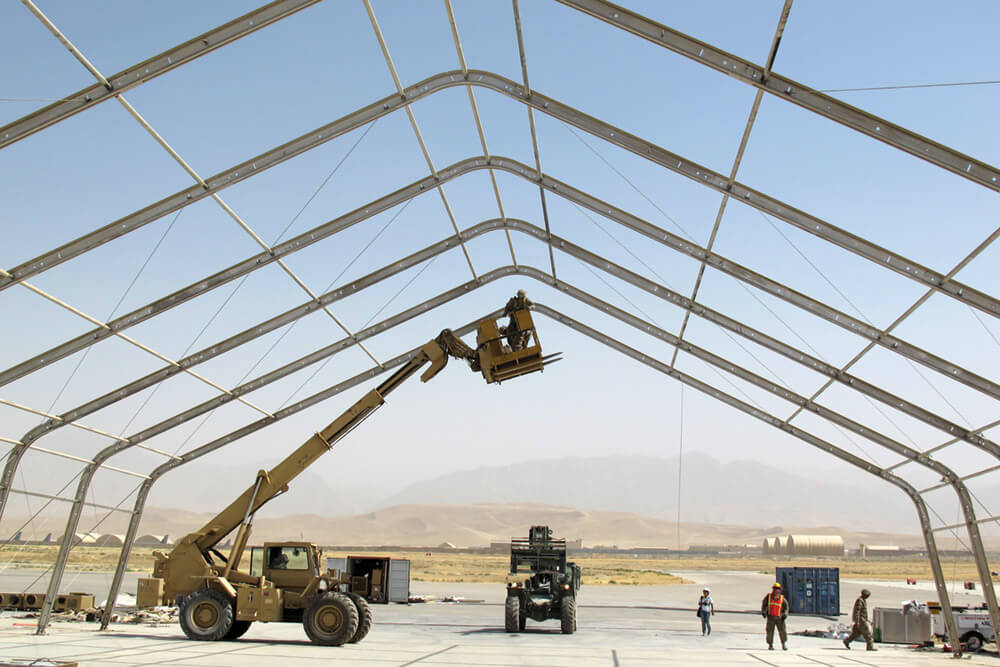
As part of a massive effort to dismantle military facilities in Afghanistan, Wisconsin National Guard soldiers use forklifts — and muscles — to break down a large aviation maintenance hangar near Mazar-i-Sharif that was used to repair Blackhawk, Chinook, and Apache helicopters. Photo: Meg Jones
The UW — and some of its graduates — are playing key roles in bringing back the unfathomable amount of stuff that has supported military operations overseas.
CAMP MARMAL, AFGHANISTAN — Engineers usually build things. They don’t often tear them down.
But as America’s longest war winds down in Afghanistan, U.S. forces are rapidly breaking down military facilities and recycling as much equipment as possible. The number of American troops is dropping from 30,000 during the summer to just under 10,000 by New Year’s Day.
It’s an unprecedented mission, costing the U.S. Department of Defense billions of dollars to recycle hundreds of thousands of pieces of equipment that have been used to support Operation Enduring Freedom for more than a decade — artillery, Humvees, desks, computers, bunk beds, stoves, radios, rifles, pool tables, latrines, and on and on.
Rather than blowing up or bulldozing buildings, in Afghanistan the troops are dismantling the facilities piece by piece to save as much as possible.
Everything will be sent back to America, given away to Afghan security forces, or destroyed to prevent it from falling into the hands of terrorists. And the hundreds of command posts and forward operating bases (FOBs) — which sprang up like mushrooms as U.S. and coalition forces flooded in to defeat the Taliban following the 9/11 terrorist attacks — will soon shut down.
Among the units packing up a war is the Wisconsin National Guard’s 829th Engineer Company, headquartered in Chippewa Falls with detachments in Ashland and Richland Center. The Wisconsin packers arrived in Afghanistan in June and are scheduled to return home before the end of the year, when combat operations will cease. The unit includes several UW–Madison alumni, such as 1st Lt. Jessica Burch ’04, the leader of the company’s third platoon.
“We’re taking it down, bringing it home,” says Burch, who earned her degree in interior design. “There are enormous challenges. We’ve learned to be creative in getting the tools and the job done. We’re probably doing more manual labor than normal.”
The challenges include the intense heat and unrelenting sun, which quickly overheat power tools and the soldiers wielding them. To combat triple-digit temperatures, power tool batteries are stored in coolers, and the Wisconsin engineers each consume dozens of bottles of water and power drinks during the workday.
Under such conditions, soldiers must wear long-sleeved shirts and gloves so they don’t burn their skin on tools left in the sun. And they can work only thirty minutes before resting thirty minutes.
“You can only plan four hours of work in an eight-hour day,” says 1st Lt. Jeffrey Koehler ’04, commander of the fourth platoon, yet the work must still get done within the deadlines set by commanders.
Shortly after arriving, the engineers were split into four groups and sent to bases in northern and eastern Afghanistan to break down hundreds of tents, dining facilities, tactical operation centers, maintenance facilities, and other structures. They pulled miles of electrical wire and plumbing pipes, moved dozens of tall concrete T walls with the help of cranes, and dismantled incinerators no longer needed to burn the mountains of garbage produced daily at sprawling bases. Many of the soldiers serving in the 829th are mechanics, electricians, plumbers, and carpenters in both their military and civilian careers.
“It’s the complete opposite of what we normally do,” says Koehler, who earned his UW degree in electrical engineering. “Instead of nailing up plywood, it’s taking a crowbar and pulling it off.”
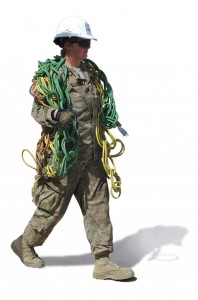
Spc. Erika Steinke of Wilton, Wisconsin — a member of the Wisconsin National Guard — is draped in electrical wiring removed from the maintenance hangar. Officials estimate that, ultimately, three-quarters of a million pieces of equipment will be packed up and returned to the United States. Photo: Meg Jones
But knowing how buildings are constructed gives the Wisconsin soldiers a useful set of skills to devote to this task. They don’t have to search for electrical wiring hidden beneath floors — they know exactly where it is. They don’t have to guess which walls are load bearing. And they have installed so many latrines that knowing how to disconnect plumbing pipes from drains and water sources is second nature.
Raw materials such as plywood, insulation, and metal roofing, along with furnishings, tents, and fixtures, are being sent to sorting facilities at a few of the large bases in Afghanistan to be recycled and redistributed, says Burch, who used a black marker to decorate her red hard hat with a drawing of Bucky Badger.
Just a few weeks — and sometimes only days — earlier, these tents, chow halls, and aviation facilities fed hungry service members or housed Blackhawk helicopters. Now soldiers tear them down, leaving behind ghostly footprints in the sand. Concrete pads and anchor bolts are being broken up and hauled away with the goal of returning the Afghan terrain to what it looked like before the war.
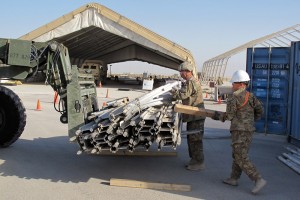
Two members of the Wisconsin National Guard, Staff Sgt. Tom Hinman of Hazel Green, at left, and Spc. Taylor Wahlberg of Superior, pile beams onto a forklift as an aviation maintenance hangar is dismantled at Camp Marmal. Photo: Meg Jones
While the Wisconsin engineers travel to Afghanistan with the tools and equipment they need, to meet tight deadlines, much of it is shipped back home before they can finish their tasks. That means they’ve had to come up with alternative ways to accomplish the job. For example, large aviation maintenance tents are typically dismantled by using giant winches to pull down the tent skins. But at Camp Marmal, located near the northern Afghanistan city of Mazar-i-Sharif, Burch’s platoon doesn’t have giant winches. So the soldiers are using ratchet straps and flagpoles that they cut up and repurposed as roll bars to safely bring down the tents.
“That was the guys’ most proud moment. They were like, ‘Ma’am, look what we made!’ ” says Burch.
On the other end of the pipeline of equipment and gear flowing out of Afghanistan is Teresa Adams, a UW professor of civil and environmental engineering. As executive director of the UW-based National Center for Freight and Infrastructure Research and Education, Adams is among the analysts figuring out how all the military equipment will come back to the United States and where it will go.
Though weapons, ammunition, and sensitive equipment — such as computers and sensors — will return home via cargo planes, most equipment will come by sea, says Adams.
After analyzing deep-water ports and nearby rail and intermodal lines to ship military vehicles and equipment, Adams recommended the Port of Gulfport, Mississippi, as an entry point. The location offers access to the Gulf of Mexico, an extensive system of rail tracks and highways, airports that can handle C-5 and C-17 cargo planes, and the nearby Camp Shelby, a large military base.
“This effort is unprecedented anywhere in the world. Three-quarters of a million pieces of equipment will be returned,” says Adams, noting that prior to the wars in Iraq and Afghanistan, American military equipment was simply left behind or given away.
“This time the stage is different,” she says. “The military is thinking sustainability and cost-saving. They are looking at opportunities to repurpose and resell, and how they can save with the logistics of transporting to a U.S. port and then inland to the Army Depot destinations. They want to deliver and redeploy effectively, and with the least cost. This is a new spin, it seems.”
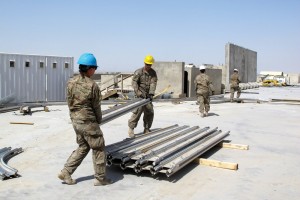
Soldiers must wear gloves and long sleeves while working, above, because tools and metal left out in Afghanistan’s triple-digit heat can quickly burn skin. Photo: Meg Jones
At FOB Fenty, Staff Sgt. Colleen Anderson ’09 is a team leader and the noncommissioned officer in charge of safety for the second platoon. FOB Fenty is the American base at the airfield next to Jalalabad, and it’s from there that SEAL Team Six left in helicopters on the Osama bin Laden mission into nearby Pakistan and returned with bin Laden’s body.
The platoon’s soldiers are knocking down facilities and closing portions of Fenty because, by year’s end, only Afghan security forces will remain at the airfield. At the same time, they are constructing temporary housing to handle the influx of U.S. and coalition military members and civil contractors who are leaving the numerous installations that have been closed down nearby.
“Our mission is figuring out what to do with all of the materials so we’re not wasting anything [and] so we can possibly use them elsewhere,” Anderson says during a break from helping dig a trench for electrical lines. “As the war is drawing down, we’re reallocating materials to save the government money.”
This is Anderson’s second deployment to Afghanistan. She was here in 2012 with a Wisconsin National Guard unit of agriculture specialists that helped Afghan farmers in Kunar Province. Because of her UW–Madison zoology degree — and the time she spent as a student volunteering at the zoological museum in the Noland Zoology Building — she was selected to serve on the veterinary team, working on pest eradication and helping to manage the unit’s Afghan interpreters.
She often wonders what it would be like to return to this war-torn country as a tourist.
“I thought, militarywise, I’d never come back. But I like the culture and the beautiful landscape, so if there was more stability, I could totally see coming back in thirty years,” says Anderson, who was a member of Hoofers while she was a student. “I told some of my friends this would be a great place to backpack.”
Meg Jones ’84, a reporter for the Milwaukee Journal Sentinel and a freelance writer, traveled to Afghanistan in August 2014. Her trip was supported by the Pulitzer Center on Crisis Reporting.
Published in the Winter 2014 issue
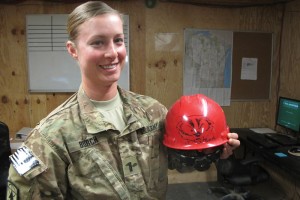
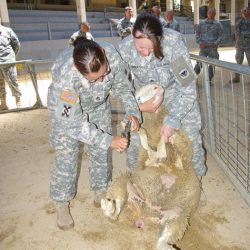

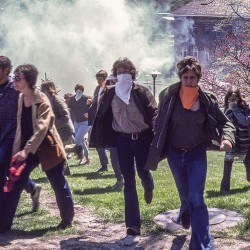
Comments
No comments posted yet.